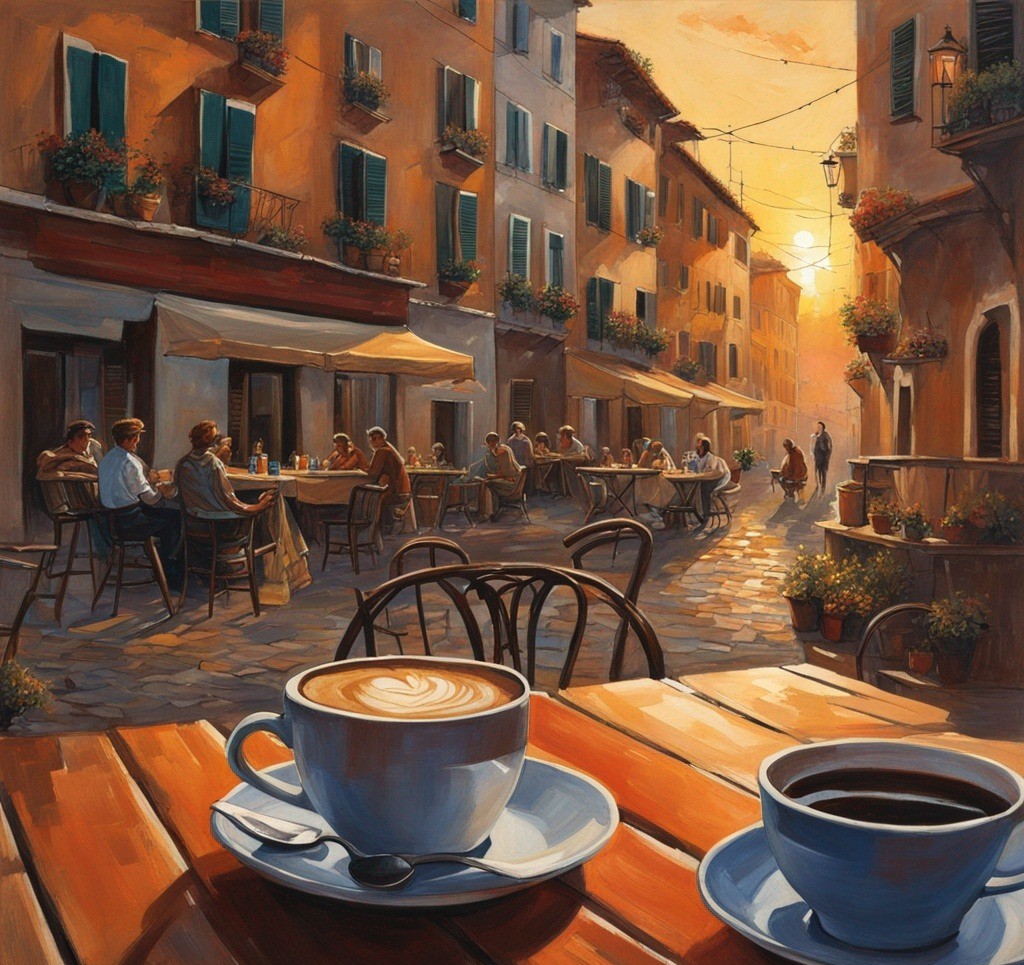La Dolce Vita Hour
The Italians have a phrase that perfectly captures what happens in their piazzas at sunset: "la passeggiata"—the evening stroll that transforms ordinary streets into theaters of life, conversation, and connection.


The first time I experienced a proper Italian sunset from a café table, I finally understood what writers have been trying to capture for centuries. It wasn't just the visual beauty—though that was undeniable—but the entire sensory experience that felt like stepping into another dimension of living.
It happened in a small town in Umbria, not far from Perugia. I'd spent the day wandering medieval streets, my feet protesting after hours of navigating cobblestones and hillside inclines. As the afternoon light began to soften, I found myself drawn to a simple café on a narrow street lined with those distinctly Italian ochre buildings, their shutters painted in faded blues and greens.
I claimed a small table facing the street, ordered a macchiato and, on the waiter's recommendation, a small glass of local amaro—"to restore the spirit," he insisted with a knowing smile. As I settled in, the town began its transformation.
What makes an Italian sunset so extraordinary isn't just the quality of light, though that golden Mediterranean glow does possess a distinctive warmth that seems to illuminate buildings from within. It's what happens beneath that light—the social choreography that unfolds with such natural grace it seems rehearsed.
First came the older gentlemen, emerging from their homes in pressed shirts and light sweaters despite the lingering warmth, claiming their regular tables at the café across the street. They greeted each other with handshakes that turned into clasped shoulders, familiar rituals of acknowledgment. Their conversations rose and fell like music—animated debates punctuated by laughter, hands gesturing in emphasis, faces expressive and engaged.
Next, the families appeared. Children released from the constraints of school or afternoon rest hours raced ahead of parents, their energy and voices filling the growing shadows. Neighbors called greetings from windows above, conversations carried across streets and between balconies. Young mothers pushed strollers while grandmothers walked slowly behind, keeping watchful eyes on toddlers who had recently discovered their independence.
As the golden light intensified, painting the walls of the buildings in shades of amber and rose, the younger adults began to emerge—couples walking with hands intertwined, groups of friends moving with the easy confidence of those who know they have the entire evening ahead of them. They stopped to chat with the older men, bending to accept kisses on cheeks from grandmothers, creating brief intergenerational islands in the steady stream of movement.
All the while, the café staff moved with practiced efficiency, delivering tiny cups of espresso, glasses of wine, small plates of olives and chunks of Parmesan. My waiter noticed my empty cup and raised an eyebrow in question. I nodded, and moments later a fresh macchiato appeared before me, the perfect ratio of espresso to milk, the foam creating a small mountain topped with a dusting of cocoa.
"È bello, vero?" he asked—It's beautiful, isn't it?
"Si, bellissimo," I replied, my limited Italian suddenly feeling wholly inadequate to express what I was witnessing.
He gestured broadly to encompass not just the sunset but the entire scene. "Questo è il nostro tesoro," he said. This is our treasure.
In that moment, I understood something fundamental about Italian culture that no guidebook had adequately explained. This evening ritual—the passeggiata, the gathering in public spaces, the unhurried conversations over coffee or wine—wasn't just a quaint cultural tradition. It was indeed a treasure, a daily investment in community and connection, a collective agreement to pause and acknowledge that life is happening right now, all around us.
In my own country, sunset often catches us unaware—we're driving home from work, faces illuminated by the blue light of phones, perhaps noting the pretty colors in the sky before returning to our endless to-do lists. But here in this Italian piazza, sunset was an event, a celebration, a momentary suspension of individual concerns in favor of collective experience.
What struck me most was how the café culture facilitated this connection. These weren't expensive establishments with elaborate menus. They were simple spaces with a few tables, basic offerings, and staff who recognized that their role went beyond service to something more like stewardship—they were maintaining spaces where community could happen.
The café where I sat that evening was called "Da Marco," I later learned—simply "At Marco's"—named for the owner whose father and grandfather had operated it before him. Marco himself emerged as the sunset reached its peak intensity, greeting regulars by name, stopping at tables to engage in brief conversations, clapping a returning customer on the back with genuine pleasure.
When he reached my table, he paused, noting my solitary state and perhaps the look of wonder on my face.
"Prima volta in Italia?" he asked—First time in Italy?
When I nodded, he smiled and gestured to the street, the buildings now glowing as if lit from within, the sky deepening to shades of orange and pink above. "You have good timing," he said in accented English. "This is Italy at its most honest."
I've thought about that phrase many times since—"Italy at its most honest." What Marco understood, what the scene before me demonstrated, was that the essence of Italian culture isn't found in its museums or monuments, magnificent though they are. It's found in these daily moments of connection, in the prioritization of presence over productivity, relationship over efficiency.
As darkness finally settled over the piazza, the streetlights flickered on, creating pools of warm light that extended the golden hour's glow. The atmosphere shifted subtly—conversations grew quieter, more intimate, body language more relaxed. Some of the older gentlemen began to make their way home, while the younger crowd continued to arrive, the piazza seamlessly transitioning from early evening gathering to night's possibilities.
I ordered a glass of the local red wine, a simple Sangiovese that tasted of cherries and earth, and watched as the street continued its gentle choreography. A couple at the next table noticed my interest and smiled, the woman offering me a piece of the focaccia they were sharing. This small gesture of inclusion—so natural to them, so unexpected to me—nearly brought tears to my eyes.
In the years since that first Italian sunset, I've sought out similar experiences in piazzas across the country—from the grand spectacle of Rome's Piazza Navona to tiny unnamed spaces in hillside villages. The specific setting changes, but the essential qualities remain: that golden light, the multi-generational mixing, the unhurried conversations, the sense that this moment matters.
I've learned to recognize the signs of an authentic experience versus one staged for tourists. The real Italian sunset café scene involves locals outnumbering visitors, reasonable prices, simple menus, and most importantly, that indefinable quality of people truly seeing each other—engaging rather than performing.
In our increasingly digital world, where connection is often mediated through screens and algorithms, these physical gathering spaces become even more precious. They remind us that human beings are fundamentally social creatures, that we need the rhythmic reassurance of familiar faces in familiar places, that we are at our best when we pause to acknowledge each other's existence.
So the next time you find yourself in an Italian town as the afternoon light begins to soften, look for a simple café with a few outdoor tables. Order something small—a coffee, a glass of wine—and settle in. Watch as the theater of life unfolds before you, as the buildings begin to glow with that distinctive golden light, as the community emerges to celebrate another day's completion.
You might find, as I did in that Umbrian piazza, that the most authentic Italian souvenir isn't something you can buy but something you can experience: the simple, profound pleasure of being fully present as day transitions to night in a culture that has elevated that transition to an art form.
Get in touch


